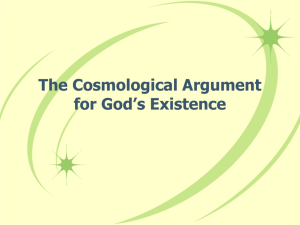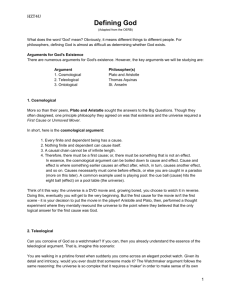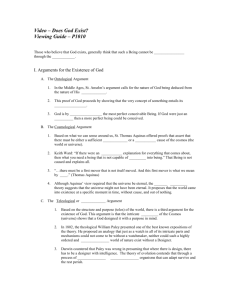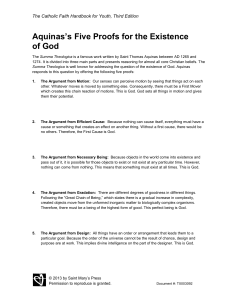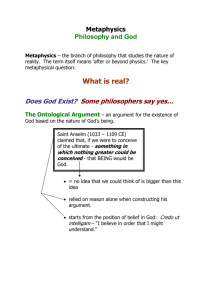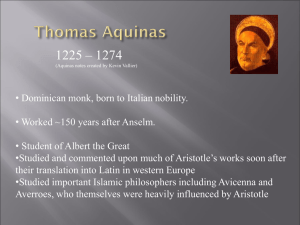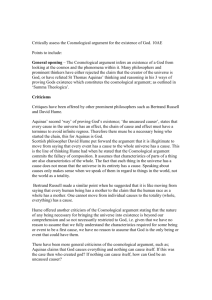The cosmological and design (teleological) arguments
advertisement
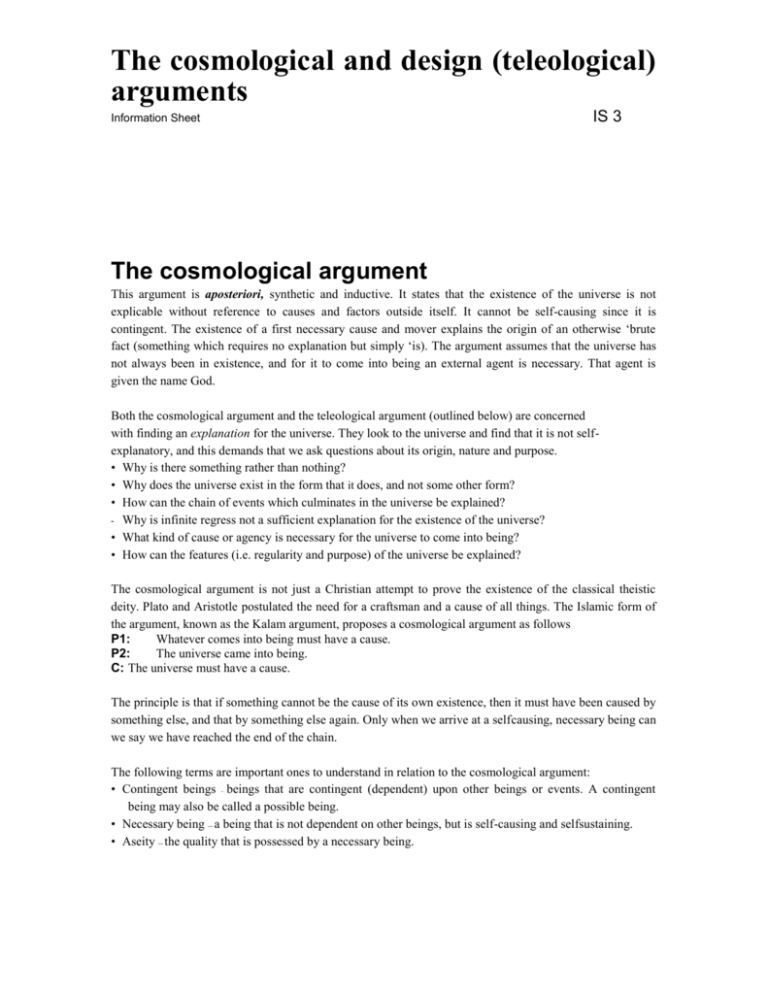
The cosmological and design (teleological) arguments IS 3 Information Sheet The cosmological argument This argument is aposteriori, synthetic and inductive. It states that the existence of the universe is not explicable without reference to causes and factors outside itself. It cannot be self-causing since it is contingent. The existence of a first necessary cause and mover explains the origin of an otherwise ‘brute fact (something which requires no explanation but simply ‘is). The argument assumes that the universe has not always been in existence, and for it to come into being an external agent is necessary. That agent is given the name God. Both the cosmological argument and the teleological argument (outlined below) are concerned with finding an explanation for the universe. They look to the universe and find that it is not selfexplanatory, and this demands that we ask questions about its origin, nature and purpose. • Why is there something rather than nothing? • Why does the universe exist in the form that it does, and not some other form? • How can the chain of events which culminates in the universe be explained? - Why is infinite regress not a sufficient explanation for the existence of the universe? • What kind of cause or agency is necessary for the universe to come into being? • How can the features (i.e. regularity and purpose) of the universe be explained? The cosmological argument is not just a Christian attempt to prove the existence of the classical theistic deity. Plato and Aristotle postulated the need for a craftsman and a cause of all things. The Islamic form of the argument, known as the Kalam argument, proposes a cosmological argument as follows P1: Whatever comes into being must have a cause. P2: The universe came into being. C: The universe must have a cause. The principle is that if something cannot be the cause of its own existence, then it must have been caused by something else, and that by something else again. Only when we arrive at a selfcausing, necessary being can we say we have reached the end of the chain. The following terms are important ones to understand in relation to the cosmological argument: • Contingent beings beings that are contingent (dependent) upon other beings or events. A contingent being may also be called a possible being. • Necessary being a being that is not dependent on other beings, but is self-causing and selfsustaining. • Aseity the quality that is possessed by a necessary being. - — — Aquinas and the cosmological argument The most famous Christian application of the cosmological argument was offered by Thomas Aquinas (1224—74) in Summa Theologica. He proposed Five Ways that proved the existence of God of which the first three are cosmological arguments, the fourth a form of ontological argument and the fifth a teleological argument. The first way: from motion it is certain, and evident to our senses, that in the world some things are in motion. Now whatever is moved is moved by another.... it is therefore impossible that in the same respect and in the some way a thing should be both mover and moved.... If that by which it is moved be itself moved, then this a/so must needs be moved by another.... But this cannot go on to infinity, because then there would be no first mover, and, subsequently, no other mover.. . . Therefore it is necessary to arrive at a first mover, moved by no other; and this everyone understands to be God. Thomas Aquinas, Summa Theologica, Third Article, Whether God Exists?' • Nothing can move itself, yet things are evidently in motion. • An infinite chain of movers which has no beginning can have no successive or ultimate movers. - There must therefore be a first mover that causes motion in all things, and this Aquinas called God. • Aquinas called motion the reduction of something from potentiality to actuality' For example, fire, which is actually hot changes wood, which is potentially hot, to a state of being actually hot. Motion, therefore, is a change of state and not just movement in rime and space from one place to another. The second way: from cause The second way is from the nature of efficient cause. In the world of sensible things we find there is an order of efficient causes. There is no case known (neither is h indeed, possible) in which a thing is found to be the efficient cause of itself for so it would be prior to itself which is impossible.. . Therefore it is necessary to admit to a first efficient cause, to which everyone gives the name of God. (op. cit.) This follows the same lines of reasoning as the first way: all things are caused and since nothing can be its own cause (a logical impossibility), there must be a first cause (God) on which all other causes depend. An infinite chain of causes is rejected since in an infinite chain there can be no first cause. The third way: from necessity and contingency The third way is taken from possibility and necessity.. . . We find in nature things that are possible to be and not to be, since they are found to be generated, and to be corrupted, and consequently it is possible for them to be and not to be... There fore if everything can not-be then atone time there was nothing in existence., fond] it would have been impossible for anything to have begun to exist and thus even now nothing would be in existence, which is absurd.... Therefore we cannot but admit the existence of some being having of itself its own necessity, and not receiving it from another but rather causing in others their necessity. This all men speak of as God. (op. cit.) Hence: • Everything we can point to is dependent upon factors beyond itself and thus is contingent. • Its presence can only be explained by reference to those factors which themselves depend on other factors. - These factors demand an ultimate explanation in the form of a necessary being (God) dependent on nothing outside himself. • God’s necessary existence is established de re i.e. by the very nature of things in the universe, so that God exists necessarily and not contingently. E C. Copleston defmes such a being as one that must and cannotnot-exist. The cosmological and design (teleological) arguments nformaton Sheet continued _I*_ In 1710 Leibniz (1646—1716) explained the cosmological argument according to the principle of sufficient reason: Suppose the book of the elements of geometry to have been eternal, one copy having been written down from an earlier one. It is evident that even though a reason can be given for the present book out of a past one, we should never come to a full reason. What is true of the books is also true of the states of the world. If you suppose the world eternal, you wi/I suppose nothing but a succession of states, and will not find in any of them a sufficient reason. Leibniz’s argument is that even if the universe had always been in existence it would still require an explanation, or a sufficient reason for its existence, since we need to establish why there is something rather than nothing. By going backwards in time for ever we will never arrive at such a complete explanation. J. L. Mackie (1917—81) supports Aquinas’s rejection of infinite regress with a modern analogy: we would not expect a railway train consisting of an infinite number of carriages, the last pulled along by the second last, the second last by the third last and so on, to get along without an engine. This analogy demonstrates the principle of dependency in the argument. In an infinite series of causes and effects there is nothing to support them. God is like an engine not just another truck, but a machine which has the power to move without requiring something else to act upon it. - EvaIuating the argument David Hume (1711-76) proposed the classical criticisms of the cosmological argument in Dialogues Concerning Natural Religion (1779). • The notion of a necessary being is an inconsistent one since there is no being the non-existence of which is inconceivable. Even if there was such a being, why should it be God? Hume stated: Any particle of matter, it is said, may be conceived to be annihilated, and any form may be conceived to be altered. Such an annihilation or alteration is not therefore impossible. But it seems a great partiality not to perceive that the same argument extends equally to the Deity, so far as we have any conception of him... • Why should the first mover/cause be the God of classical theism? Aquinas is guilty of an inductive leap of logic in moving from the need for a first mover to identifying it as God. - The argument begins with a concept familiar to us the universe but reaches conclusions about things that are outside our experience. - Why do we need to find a cause for the whole chain if we can explain each item in the chain? Hume wrote: — — Did I show you the particular causes of each individual in a collection of twenty particles of matter, / should think it very unreasonable should you afterwards ask me what was the cause of the whole twenty. This is sufficiently explained in explaining the cause of the parts. Even if specific instances of things in the universe require an explanation, why should this be the case for the universe as a whole? Neither can we work from the specific to the general: Bertrand Russell (1872— 1970) observed that just because every individual has a mother it does not mean that all humankind has one universal mother Why does anything need an explanation? In dialogue with Copleston, Russell claimed that some things are ‘just there’ and require no explanation, and the universe was such a case. It is a ‘brute fact'. Copleston famously replied: ‘If one refuses to sit down at the chessboard and make a move, one cannot be check-mated.’ Russell was in effect withdrawing from the debate by refusing to consider that it was valid to ask questions about origins. Strengths of the argument • A posteriori arguments draw on the evidence which is universally available and which in itself cannot be challenged. • While John Hick maintained that “The atheistic option that the universe is “just there” is the more economical option’, Richard Swinburne, using the principle of Ockham’s razor (see page 33), disagrees, arguing that ‘God is simpler than anything we can imagine and gives a simple explanation for the system’. • ‘The question is: is there an unanswered question about the existence of the world? Can we be puzzled by the existence of the world instead of nothing? I can be and am; and this is to be puzzled about God.’ Herbert McCabe, A Modern Cosmological Argument (New Blackfriars, Vol. 61, 1980) The teleological (design) argument This is another a posteriori, synthetic and inductive argument. It states that certain phenomena within the universe appear to display features of design in so far as they are perfectly adapted to fulfil their function. Such design cannot come about by chance and can only be explained with reference to an intelligent, personal designer. It is possible to draw an analogy between the works of human design and the works of nature, which leads us to conclude that there are sufficient similarities to infer design of a similar nature. Since the works of nature are far greater than the works of man, an infinitely greater designer must be postulated, which points towards the existence of God as the one who possesses the necessary attributes. Aquinas’s fifth way: from the governance of the world We see that things which lack knowledge, such os natural bodies, act for an end, and this is evident from their acting a/ways, or nearly a/ways, in the same way, so as to obtain the best result Hence it is plain that they achieve their end not fortuitously but designedly. Now whatever locks knowledge cannot move towards on end, unless it be directed by some being endowed with know/edge and intelligence.. .and this being we call God. Thomas Aquinos, Summa Theologica William Paley and the watch Just as the discovery of a watch on a heath could not be satisfactorily explained by saying it had ‘always been there’, the order evident in the universe demands an explanation. For William Paley (1743—1805) the watch serves as an analogy for the world: it demonstrates purpose, design and telos (an end or ultimate function). All parts of the watch unite to fulfil that function and this unity cannot be explained by chance. Even if we have never seen a watch before we could still deduce that it had been designed, and even if parts of it appear to malfunction, or if we cannot work out the function that individual parts contribute to the whole, it does not disprove that it has been designed. F. R. Tennant: design and evolution The fitness of the world to be the home of living beings depends on certain primary conditions astronomical, thermal, chemical, etc. and on the coincidence of qualities, apparently not casually connected to each other The unique assembly of unique properties on so vast a scale makes the organic world corn parable to a single organism... The world is compatible with a single throw of the dice and common sense is not foolish in suspecting the dice to have been loaded. Cited in Peter Vardy, The Puzzle of God Collins Flame, 1990), p. 93 Tennant also proposed an aesthetic form of the argument, which states that beauty, music and art do not have any part to play in the survival of the fittest, but suggests a personal designer with a concern and interest in his creation that goes beyond mere survival. Richard Swinburne: the probability of design Richard Swinburne argues that theism is the best explanation for the design that is apparently evident in the universe, and points not only to the order and purpose which it displays but to the providential nature of the universe it contains within it everything that is necessary for survival. — He maintains that it is a universe in which humankind is designed to occupy the highest position and that natural laws function within the universe, making it a place where humankind can meaningfully contribute to its development and maintenance. The value of the argument There is common acknowledgement that the universe appears to betray evidence of design and order. Even David Hume wrote: A purpose, an intention, a design, strikes everywhere the most careless, the most stupid thinker.’ Hymns and poetry have praised the craftsmanship evident in the world: ‘All things bright and beautiful, all creatures great and small, all things wise and wonderful, the Lord God made them all’ (C. F. Alexander). Gerard Manley Hopkins wrote: ‘The world is charged with the grandeur of God’, and was famous for seeing God’s hand in nature despite the attempts by humans to despoil his work. Scientific explanations of the universe could be seen as being compatible with the argument since evolution or even a cosmic explosion could simply be the means with which the designer achieved his creation. In the late nineteenth century Archbishop ‘Temple claimed: ‘The doctrine of evolution leaves the argument for an intelligent Creator and Governor of the earth stronger than it was before.’ Richard Swinburne maintains: ‘The very success of science in showing us how deeply orderly the natural world is provides strong grounds for believing that there is an even deeper cause of that order’ (The Existence of God, OTJP, 1979, p. 68). Weaknesses of the argument • David Hume argued that to make an analogy between the universe and the works of humankind is highly dangerous to the theist since it leads inevitably to anthropomorphism. God’s qualities and characteristics are so closely identified with those of humankind in order to make the analogy work that it removes from him the divine distinctiveness that the believer surely wants to preserve. If God is to be compared with a human designei then it serves only to emphasise his limitedness, changeability and fallibility, and in no way serves to support the view that a single deity of infinite capacity designed and created the universe with a benevolent interest in his creatures. • The presence of order could be explained in many ways without reference to God. Since the universe is religiously ambiguous it cannot be assumed that God is the only explanation for its features. • Evil and suffering could be said to deal a significant blow to the argument. John Stuart Mill (1806—73) wrote~ ‘Next to the greatness of these cosmic forces, the quality which most forcibly strikes everyone who does not avert his eyes from it is their perfect and absolute recklessness. They go straight to their end, without regarding what or whom they crush on their road’ (cited in The Existence of God, ed. John Hick, Macmillan, 1964, p. 115). • Whether the argument succeeds or fails depends entirely on how each individual judges the evidence, Some may maintain that there is insufficient evidence for claiming that there is design in the universe at all, still less that it can only be explained with reference to God. Just as Hick’s travellers on the road to the Celestial City interpret the evidence they encounter in different ways, so too can the evidence proposed by supporters of the teleological argument be variously and legitimately interpreted. The cosmological and design (teleological) arguments Worksheet 1 There is a wealth of material here on the cosmological argument, and more to be found in the resources your teacher provides. Summarise it now, with the exam in mind. You will need to be able to write about one or two arguments in no more than 45—50 minutes, so you cannot say everything. Start creating a revision pack before you leave this topic behind, and aim to reduce all the material you have been given to the amount that you can deal with efficiently in the time you will have in the exam. 2 Many questions on these arguments are linked with a catalyst quotation which you are expected to relate to the material you have studied. Think about how you would ensure you made the following exam paper quotations illustrate your answer rather than ignoring them and just writing everything you know about the argument. For homework choose at least two of the following questions and write them under timed conditions. • How far do both the cosmological and teleological (design) arguments serve to provide a coherent explanation of the universe? • Arguments for the existence of God have some strengths, but do not prove the existence of God. Discuss. • ‘It is possible for there to be a consistently religious and a consistently atheistic interpretation of the universe? How far do the cosmological or teleological arguments serve to support a consistently religious interpretation of the universe? • Consider how far the creation of the world is analogous to the human invention of computers. • Consider the view that the cosmological or teleological arguments are essentially difficult to destroy. 3 The cosmological and design arguments are both inductive in their approach. Consider the specific problems that are raised by this approach with reference to the two arguments. 4 Richard Swinburne considers these arguments to be more likely explanations for the universe and its characteristics than a non-theistic explanation. What might contrthute to choosing to see the world in religious rather than non-religious terms?

